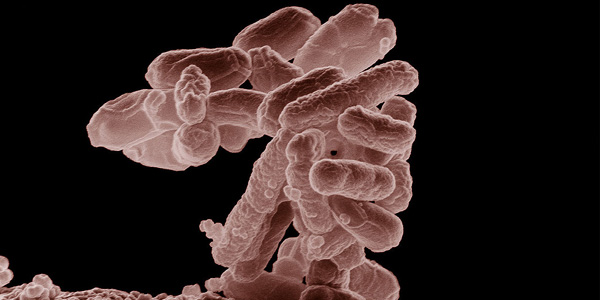
Low-temperature electron micrograph of a cluster of E. coli bacteria, magnified 10,000 times. Photo by Eric Erbe, digital colorization by Christopher Pooley, both of USDA, ARS, EMU.
Overview
FoodNet is a collaborative project of the Centers for Disease Control and Prevention (CDC), the EIP network, the US Department of Agriculture (USDA), and the Food and Drug Administration (FDA). CEIP’s FoodNet project works in close partnership with local and state health jurisdictions to implement active surveillance and epidemiologic studies designed to help public health officials better understand the epidemiology of foodborne diseases in the United States. The ten FoodNet sites nationwide serve as a network for responding to new and emerging foodborne diseases of national importance.
Objectives
- Determine the burden of foodborne illness in the United States
- Monitor trends in the burden of specific foodborne illness over time
- Attribute the burden of foodborne illness to specific foods and settings
- Disseminate information that can lead to improvements in public health practice and the development of interventions to reduce the burden of foodborne illness
Main Components
- Active surveillance for selected foodborne pathogens
- Enhanced foodborne outbreak response and reporting
- Physician, population, and laboratory surveys
- Special studies
Surveillance
The core activity of CEIP’s FoodNet project is laboratory-based active surveillance at over 30 clinical and reference laboratories that test stool samples in the catchment area, which consists of Alameda, Contra Costa, and San Francisco counties. FoodNet personnel identify and collect demographic, clinical, epidemiologic, and laboratory information on all laboratory-confirmed cases of selected foodborne illnesses from catchment area laboratories.
Case Definitions
Pathogens under surveillance include Salmonella, Shigella, Campylobacter, Shiga toxin-producing E. coli (STEC), Listeria monocytogenes, Yersinia, Vibrio, Cryptosporidium, and Cyclospora. In addition to laboratory surveillance for these pathogens, FoodNet conducts active surveillance for pediatric hemolytic uremic syndrome (HUS) through a network of nephrologists in the catchment area.
Data Overview
Data are transmitted electronically to CDC and combined with data from other EIP FoodNet sites for analysis. Trends in incidence are published annually in the Morbidity and Mortality Weekly Report (MMWR). FoodNet data are also used for other analyses such as periodic estimates of the burden of foodborne illness in the United States.
Completed Studies
1. Cohort Study of Clinical Outcomes in Multi-Drug Resistant non-Typhi Salmonella Serotypes (2006-2007)
CEIP conducted a multi-site, prospective cohort study to investigate the impact of infection with non-Typhi Multi-Drug Resistant (MDR) Salmonella on clinical outcome. The study’s primary objective was to determine and compare the clinical outcomes observed among cases with non-Typhi MDR Salmonella infection to those of cases with pansusceptible non-Typhi Salmonella. In addition, the study looked for variations of clinical outcomes among subgroups with reference to age, sex, and immune status. The study was carried out by (1) identifying every 10th lab-confirmed non-Typhi Salmonella case from the catchment area, (2) interviewing them, and (3) if hospitalized, extracting information about clinical course from their medical records. Salmonella study isolates were forwarded from the California Department of Public Health Microbial Diseases Laboratory (MDL) to the CDC’s National Antimicrobial Resistance Monitoring Surveillance (NARMS) laboratory for antimicrobial susceptibility testing and other microbial characterization tests. Data analysis is ongoing.
2. Case-control study of Salmonella Javiana, Salmonella Infantis, and Salmonella I 4,[5],12:i:- infections (2007)
CEIP conducted a case-control study to identify risk factors for infection by selected Salmonella serotypes, including S. Javiana, S. Infantis and S. I 4,[5],12:i:-. S. Javiana and S. I 4,[5],12:i:- are emerging serotypes that had increased by 167% and 425%, respectively, in 2004 compared to baseline surveillance data from 1996–1998 in FoodNet. In addition, S. Infantis and S. I 4,[5],12:i:- have been shown to cause multi-drug resistant infection. Risk factors for infection with these serotypes have not been well described. The study involved interview of cases and controls as well as the collection of isolates for PFGE analysis and antimicrobial susceptibility profiling. Data analysis is ongoing.
3. Cohort Study of Escherichia coli O157:H7 Infection: Antibiotic Exposure and the Risk of Hemolytic Uremic Syndrome (2006-2010)
CEIP FoodNet conducted a three-year study to explore the important public health question of whether antibiotic treatment for E. coli O157 increases the risk for development of hemolytic uremic syndrome (HUS). Previous epidemiologic studies on this topic were unable to establish definitive conclusions due to limitations on study design and sample size. FoodNet is in a unique position to conduct a population-based cohort study with a large enough sample size of persons with laboratory-confirmed E. coli O157 to provide a more robust estimate of the association between antibiotic exposure and HUS. The study involved enrolling laboratory-confirmed E. coli O157 cases ascertained through routine active surveillance. Eligible study participants were interviewed by CEIP staff using a standardized questionnaire. Data analysis is ongoing.
4. Genetic Predictors of Developing Hemolytic Uremic Syndrome (HUS) following Infection with Shiga-toxin producing Escherichia coli (STEC) (2007-2011)
The aim of this study is to identify human genomic factors associated with the development of Hemolytic Uremic Syndrome among persons infected with Shiga toxin producing E. coli and calculate the proportion of disease risk attributable to these genetic factors. Currently, the genomic factors proposed in this study have no clinical relevance, but identification of such genetic factors will contribute to a better understanding of the pathogenesis of the disease and potentially have therapeutic and preventive implications, by providing a mechanism for identifying persons at highest risk of HUS for preventive education or tailoring of therapy based on immunologic risk factors. Data analysis is ongoing.
5. FoodNet Non-O157 Shiga Toxin-Producing E. coli (STEC) Study: Assessment of Risk Factors for Laboratory-Confirmed Infections and Characterization of Illnesses by Microbiological Characteristics
This FoodNet case-control study is the first multi-state investigation of non-outbreak-associated non-O157 STEC infections in the United States. It investigates risk factors for non-O157 STEC infections, both as a group and individually, for the most common non-O157 STEC serogroups. In addition, the study will characterize the major known virulence factors of non-O157 STEC to assess how risk factors and clinical features vary by virulence factor profiles. As the largest, most comprehensive, and most powerful study of its kind, it could make an important contribution towards better understanding of non-O157 STEC infections and to providing science-based recommendations for interventions to prevent these infections.
Links
Selected Publications
Clogher P, Hurd S, Hoefer D, Hadler JL, Pasutti L, Cosgrove S, Segler S, Tobin-D’Angelo M, Nicholson C, Booth H, Garman K, Mody RK, Gould LH. Assessment of physician knowledge and practices concerning Shiga toxin-producing Escherichia coli infection and enteric illness, 2009, Foodborne Diseases Active Surveillance Network (FoodNet). Clin Infect Dis 2012; 54 Suppl 5:S446-52.
Hurd S, Patrick M, Hatch J, Clogher P, Wymore K, Cronquist AB, Segler S, Robinson T, Hanna S, Smith G, Fitzgerald C. Clinical laboratory practices for the isolation and identification of Campylobacter in Foodborne Diseases Active Surveillance Network (FoodNet) sites: baseline information for understanding changes in surveillance data. Clin Infect Dis 2012; 54 Suppl 5:S440-5.
Shiferaw B, Verrill L, Booth H, Zansky SM, Norton DM, Crim S, Henao OL. Sex-based differences in food consumption: Foodborne Diseases Active Surveillance Network (FoodNet) population survey, 2006-2007. Clin Infect Dis 2012; 54 Suppl 5:S453-7.
Silk BJ, Date KA, Jackson KA, Pouillot R, Holt KG, Graves LM, Ong KL, Hurd S, Meyer R, Marcus R, Shiferaw B, Norton DM, Medus C, Zansky SM, Cronquist AB, Henao OL, Jones TF, Vugia DJ, Farley MM, Mahon BE. Invasive listeriosis in the Foodborne Diseases Active Surveillance Network (FoodNet), 2004-2009: further targeted prevention needed for higher-risk groups. Clin Infect Dis 2012; 54 Suppl 5:S396-404.
Gould LH, Jordan JG, Dunn J, Apostol M, Griffin PM; Emerging Infections Program FoodNet Working Group. Postdiarrheal hemolytic uremic syndrome in persons aged 65 and older in FoodNet sites, 2000-2006. J Am Geriatr Soc 2011; 59(2):366-8.
Contact
Katie Wymore, MPH
Project Coordinator, FoodNet
foodnet@ceip.us
